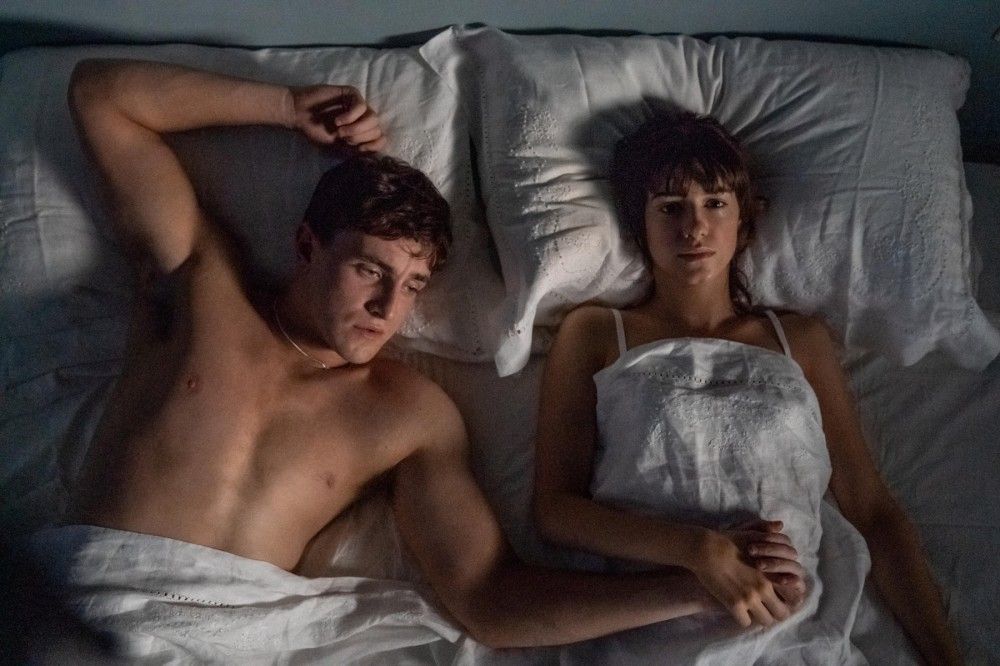
'Normal People' Might Have Realistic Sex — But the BDSM Plot Is All Wrong
If you’re suffering from quarantine-inflicted horniness, you’ve probably already sat through repeated viewings of ’s critically acclaimed drama , an adaptation of the equally critically acclaimed novel by Sally Rooney. The series has been much lauded for its depiction of the complex relationship between Connell (Paul Mescal) and Marianne (Daisy Edgar-Jones), two young, good-looking, intelligent people from opposite sides of the class divide in Dublin.
In between breakups, sending wordy emails, and exchanging longing looks over prosecco in the Italian countryside, Marianne and Connell partake in a lot of pelvis-banging, and the series has garnered a great deal of acclaim for its raw, naturalistic sex scenes. As Vulture put it, “Normal People has managed to do the seemingly impossible: convey good sex as it actually happens in real life, not good sex as it happens onscreen.” But there’s one element of the series and its source material that has garnered less attention: its depiction of and , and the role it plays in Marianne’s sexual awakening.
From the start, Marianne is depicted as a young woman with a taste for pain. When she loses her virginity to Connell, she winces, but says that she likes it; he makes her keep their relationship a secret, and she is fiercely devoted to him regardless of the emotional turmoil he forces her to undergo. As Rooney wrote in the novel, “she would have lain on the ground and let him walk over her body if he wanted.” Marianne’s sexual relationships with other men, including the tantrum-prone rich boy Jamie, are even more toxic and marked by sexual violence, which she tells Connell she enjoys. “He’s into pain. Like, inflicting it,” Marianne confesses to Connell, referring to Jaime. “Turns out he’s a bit of a sadist.” (For his part, Connell doesn’t exactly hold back in telling Marianne how he feels about her kinks: “Sounds fucking horrible,” he says, setting the stage for the series to continue to position them as bad, or inherently aberrant.)
While Marianne is studying abroad in Sweden, she has a degrading encounter with a partner named Lukas who ties her up during sex, then refuses to let her shower afterward. “You’re worthless. You’re nothing,” he says. Later, Lukas forces Marianne to pose for photos naked and tied-up, the camera lingering on the bruises on her wrists. When she begs him to stop, he is seen flagrantly ignoring her. “You asked for this,” he says, as if to justify his violation of her boundaries.
Throughout the show, Normal People depicts the dominant/submissive dynamic in neither a positive nor an accurate light. While there are certainly some who do not fall into this category, in general, the kink community puts a premium on consent, relying on negotiation about safe words and other boundaries before a “scene” (the term for a BDSM encounter), and afterwards (known as aftercare, there’s time set aside for both partners to relax and communicate about how the scene went). None of these things are depicted in Normal People. The fact that both Lukas and Jamie are violent in and out of the bedroom appears to suggest that, in the world of the series, the two naturally go hand-in-hand, which is both and pretty regressive for a show that’s drawn praise for its sex positivity.
Perhaps more to the point, Marianne’s taste for sexual debasement seems to stem from her traumatic upbringing, which is marked by physical and emotional abuse. At one point, she asks Connell to hit her during sex, and he refuses; Marianne interprets this as him casting judgment, and she storms home in tears. Within the context of the series, the viewer is led to conclude that he simply cares about her too much to strike her. Indeed, throughout the series, Connell is consistently depicted as her savior and protector, rushing to Marianne’s defense whenever she is abused by the carousel of violent men in her life. This portrayal doesn’t just run counter to Rooney’s repeated assertion of her protagonist’s independence and intelligence, it also lends an extra layer of creepiness to the many Normal People fangirls creating fan pages for Connell’s necklace on Instagram.
The show follows up this scene with Marianne’s brother drunkenly throwing a bottle at her, and giving her a bloody nose, as if to drive the point home that her masochistic urges stem from deep-seated familial trauma. This is a common trope, from Secretary to 50 Shades of Grey, says Mistress Couple, a relationship and intimacy coach, and BDSM expert. “Yet again, we have a story about a ‘damaged’ woman who wants to be hurt, and males who either derive sadism from emotional abuse rather than consensual sexual dominance, or who denounce sadism all together and are seen as saints.” It is not entirely uncommon for people to be drawn to explore submission due to wanting to regain control over their past trauma, but contrary to what Normal People suggests, “it is most certainly not the only reason that people are drawn to sexual submission,” she adds. “To portray it as such just perpetuates harmful stereotypes.”
While a fan of the series, Eva Oh, a BDSM trainer and creator of the Safe Word podcast, agrees that it could endorse misconceptions about BDSM held by the general public. “If I look at Normal People from the perspective of someone not as familiar with BDSM, the kink events that played out could seem dismal,” she says. The show, she says, frames BDSM as a product of abuse, rather than “a consensual process of reclamation and liberation.”
For her part, Rooney has refuted the critique that her book is a condemnation of BDSM. “I think some people have read this as me saying it’s bad to accommodate violence into sex,” Rooney told Esquire last year. “For me, it was that Connell doesn’t like BDSM, so people shouldn’t do things they don’t like…. It’s about him coming to terms with the fact that actually he has, in many ways, been dominating her all along, without wanting to admit it in himself.”
But it’s precisely this conflation of power dynamics outside the bedroom with those inside it — the idea that sexual predilections must have an origin story, that they can never exist independently of personal foibles or failings — that makes this specific subplot ring so hollow. Marianne’s taste for kink as metaphor for her self-subjugation may be a nice little storytelling device, but it’s also a fairly sex-negative and well-worn one, and it certainly doesn’t do people who share such kinks in real life any favors.
“The fact is that there are power dynamics in every relationship that exists. Period,” says Couple. “Many power dynamics are not consensual, or explicit. They simply develop out of necessity or out of a melding of survival skills. The book does a good job of putting these very real human interactions on display, but it is important to realize that these are not BDSM dynamics.”



